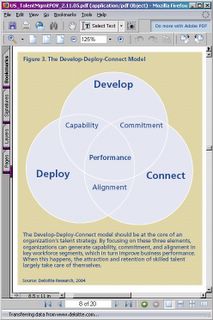Deloitte has just published Robin's excellent white paper on this topic: "It's 2008: Do You Know Where Your Talent Is?"
Note that "critical talent" rarely refers to the highest paid executives. More often critical talents are people like scientists at pharmaceutical companies, inventory managers in retail firms, or drivers for UPS.
Critical talent is scarce and is only getting more so. Companies traditionally search for critical talent amongst the ranks of their competitors, promoting a culture of Acquire (get talent) & Retain (keep it).
Robin points out that acquisition and retention are merely the endpoints of the full talent management process:
1. Acquire
2. Deploy (provide the right role and conditions for success)
3. Develop (encourage experiential learning and growth)
4. Retain
Robin notes, "The typical U.S. company spends nearly 50 times more to recruit a $100K professional than it will invest in his annual training after he comes aboard," with similarly skewed efforts at retention. She continues, "As a result, by focusing on the end points of managing talent (acquisition and retention) rather than on the middle ones (deployment and development), organizations ignore the things that matter most to employees. When this happens, companies set themselves up for inevitable churn, which becomes especially hazardous in a tight labor market."
Based on success stories from Microsoft, Southwest, and SAS, Robin explains the Develop-Deploy-Connect model of managing critical talent. These companies achieve long-term success by investing in the deployment and development, rather than fretting about acquisition and retention. Connecting, though not formally part of the four-step talent management process above, is a critical catalyst to effective development and deployment. Robin relates the three with a nifty venn diagram:

Of course there's a lot more to it than the above chart. I recommend you read Robin's report for more. For more about connecting in this context, Robin points to the work of Rob Cross and Wayne Baker, to which I would add Ron Burt.
No comments:
Post a Comment